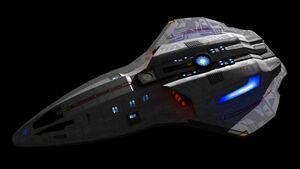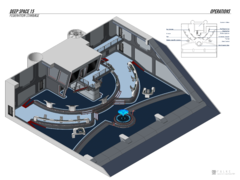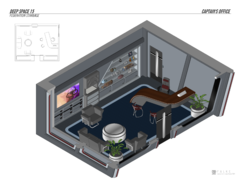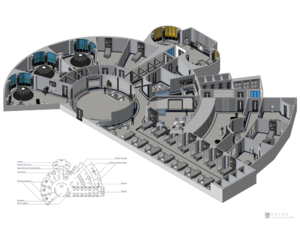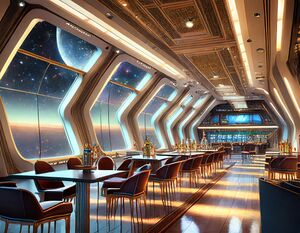Difference between revisions of "Olympia Station"
CrimsonTacit (talk | contribs) |
CrimsonTacit (talk | contribs) m |
||
| (38 intermediate revisions by 2 users not shown) | |||
| Line 1: | Line 1: | ||
{{Icons|sf}} | |||
{{Starbase | {{Starbase | ||
| name = Olympia Station | | name = Olympia Station | ||
| image = [[File: | | image = [[File:SpacedockBeautyBlue.jpg]] | ||
| registry = DS-20 | | registry = DS-20 | ||
| class = Spacedock | | class = Spacedock | ||
| Line 16: | Line 17: | ||
| sector = Olympia Sector | | sector = Olympia Sector | ||
| system = [[Olympia System]] | | system = [[Olympia System]] | ||
| co = | | co = [[bfms_char:15605|Rear Admiral Linda Stanton]] | ||
| crew =*30,000 Starfleet | | crew =*30,000 Starfleet | ||
*5,000 Civilian | *5,000 Civilian | ||
| dedication = | | dedication = [[File:OlympiaStationSeal.png]] | ||
}}'''Deep Space 20''', code-named '''Olympia Station''', is a Federation [[Spacedock Class|''Spacedock''-class starbase]] located in the Olympia system on the extreme rimward trailing edge of Federation space near Sheliak, Tholian and Tamarian space. Named along with the system it resides in for the ill-fated exploratory vessel USS ''Olympia'', this starbase serves a similar purpose to [[Deep Space 17]]: a waystation for long-range missions beyond Federation space. | }}'''Deep Space 20''', code-named '''Olympia Station''', is a Federation [[Spacedock Class|''Spacedock''-class starbase]] located in the Olympia system on the extreme rimward trailing edge of Federation space near Sheliak, Tholian and Tamarian space. Named along with the system it resides in for the ill-fated exploratory vessel USS ''Olympia'', this starbase serves a similar purpose to [[Deep Space 17]]: a waystation for long-range missions beyond Federation space. Olympia is the headquarters for [[Arcturus Squadron|Arcturus Wayfinding Squadron]] and serves all Fourth Fleet vessels deployed beyond Federation space in this region of the Alpha Quadrant. | ||
==Operations== | ==Operations== | ||
Assigned to the Fourth Fleet, Olympia Station supports the following operations in the Olympia Sector: | Assigned to the Fourth Fleet, Olympia Station supports the following operations in the Olympia Sector: | ||
* Service exploratory starships embarking on and returning from missions outside of Federation space. | *Service exploratory starships embarking on and returning from missions outside of Federation space. | ||
* Conduct scientific research on nearby systems and identify sites for future Federation colonization. | *Conduct scientific research on nearby systems and identify sites for future Federation colonization. | ||
* Monitor the expansion of the Sheliak Corporate and Tholian Assembly. | *Monitor the expansion of the Sheliak Corporate and Tholian Assembly. | ||
* Maintain diplomatic relations with the Children of Tamar. | *Maintain diplomatic relations with the Children of Tamar. | ||
=== Support | |||
Olympia Station is | === Exploratory Support === | ||
First and foremost, Olympia Station supports Federation and Starfleet vessels heading into deep space, both with physical engineering and logistics support and through sensor and communications functions. Olympia Station is the last starbase any vessel would be able to receive repairs or fuel from before heading towards the galactic edge or deeper into the Alpha Quadrant. It's also a terminus (for now) of the subspace relay network, making it the last place where anyone could hope to have synchronous or semi-synchronous conversations with superiors, friends, or family across the Federation. The station's massive computer cores are also used to collate and process exploratory information collected by missions in the area. | |||
=== Scientific Research === | |||
Olympia Station conducts its own program of scientific research in neighboring systems and across the Olympia Sector, with its support ship, the ''Nellie Bly'', and its small fleet of runabouts. Primarily, the aim is to identify planets for future colonization, but stellar mapping and general exploration are secondary priorities. | |||
=== Monitoring Regional Powers === | |||
While neither the Sheliak Corporate or the Tholian Assembly are actively hostile to the Federation, they are considered to be possible threats by Starfleet Intelligence due to their xenophobia. The Federation maintains limited diplomatic relations with these races, and one of the functions of Olympia Station is to monitor the space beyond their territory to look for signs of aggression or expansionism. | |||
=== Diplomatic Relations === | |||
Many species maintain consulates on Olympia Station, both Federation members and other powers, as they wish to be kept apprised of any first contacts made on this remote frontier. In particular, however, Olympia Station has been tasked with supporting and maintaining diplomatic relations with the Children of Tamar, promoting joint operations where possible. The following species have consulates on Deep Space 20: | |||
* Tamarians | |||
* Tellarites | |||
* Humans | |||
* Vulcans | |||
* Andorians | |||
* Betazoids | |||
* Denobulans | |||
* Klingons | |||
The Federation also maintains a diplomatic mission on the station, which works in conjunction with the station's commander and Starfleet to provide consular services to Federation citizens. | |||
===Support Vessels=== | |||
Olympia Station, as headquarters of Arcturus Squadron, generally has at least one starship available for immediate use, depending on patrol and exploration schedules. In addition to squadron vessels ''[[USS Arondight|Arondight]]'' and ''[[USS Renown|Renown]]'', which generally stay within a day's warp of Olympia, the starships ''[[USS Thomas Paine|Thomas Paine]]'' and ''[[USS Nellie Bly|Nellie Bly]]'' are assigned directly in a support capacity to Olympia Station. One of them is patrolling the system and the other is either docked or within visual range of the station at all times. | |||
[[File:ArrowRunabout4.jpg|thumb]] | |||
All twelve of the station's runabouts are [[Runabouts#Arrow-class runabout|''Arrow''-class vessels]], which are kept in a constant rotation to support exploratory missions in the surrounding sector, with two of the twelve typically held in reserve for urgent missions and for station defense. Out in the field, these small starships typically operate with a crew of twelve on six to eight-week missions. They are named for rivers in the Peloponnese of Greece, the region home to Olympia. | |||
* ''Elissonas'' | |||
* ''Fonissa'' | |||
* ''Krios'' | |||
* ''Krathis'' | |||
* ''Volinaios'' | |||
* ''Charadros'' | |||
* ''Peiros'' | |||
* ''Tytheus'' | |||
* ''Neda'' | |||
* ''Pamisos'' | |||
* ''Nedonas'' | |||
* ''Eurotas'' | |||
==Configuration== | |||
[[File:OlympiaSchematic.png|alt=Olympia Station is one of several Spacedock I-class stations that have been retrofitted with a secondary spacedock capable of housing a single explorer-type starship.|thumb|Olympia Station is one of several Spacedock I-class stations that have been retrofitted with a secondary spacedock capable of housing a single explorer-type starship.]] | |||
Compared to the stock ''Spacedock''-class station, Olympia Station has been modified many times over its nearly eighty years of life. It has modern systems and its docking facilities have been reworked to handle 25th-century starships, though these modifications did not include widening the upper bay doors, so the largest vessels must vie for space in the single large docking bay in the lower docking module. | |||
===Command and Control=== | |||
Like all large Federation stations, Olympia Station has distributed command and control facilities. There there are both redundant primary and secondary command centers, as well as numerous secondary complexes which can be activated on a moment's notice. Administration facilities for senior flag officers and the Olympia Sector itself are located in the spires above the main spacedock. | |||
====Station Operations==== | |||
Station Operations is located at the base of the upper command module on top of the spacedock centered on Door 12. This facility is heavily shielded and its large viewport can even be sealed off with a sheet of ablative armor when necessary. It is from here that all approach and docking requests are handled, before being handed off to one of the docking control centers. Tactical functions are also controlled from here, and it is the equivalent of the main bridge of a starship. This facility is identical to the four docking control complexes, and command of the station can be handled from any of them in an emergency. | |||
=====Commanding Officer's Office===== | |||
The working office of the station's commanding officer, [[bfms_char:15605|Rear Admiral Linda Stanton]], is located on the mezzanine level of Station Operations. This office contains a desk for the commanding officer, as well as a seating area for visitors. This is the location from which the admiral spends here watches of operations, but she has a larger office suite located inboard of operations, which includes various conference rooms and offices for aides.<gallery mode="packed"> | |||
File:StationOperations.png | |||
File:StationOffice.png | |||
</gallery> | |||
==== Sector Operations ==== | |||
[[File:Starbase-142-Ops.jpg|alt=Sector Operations is in one of the taller spires above the station's main body. It provides the admiral with the ability to keep tabs on operations across the Olympia Sector. There are six additional copies of this room on alternating decks down the spire to manage exploratory, strategic, humanitarian, diplomatic, pathfinding, and colonial operations.|thumb|Sector Operations is in one of the taller spires above the station's main body. It provides the admiral with the ability to keep tabs on operations across the Olympia Sector. There are six additional copies of this room on alternating decks down the spire to manage exploratory, strategic, humanitarian, diplomatic, pathfinding, and colonial operations.]] | |||
Sector Operations is a much smaller facility than Station Operations, located in one of the spires above the main body of the station. Primarily a communications center, this area allows Vice Admiral Elizabeth Hayden to stay abreast of starship movements within the Olympia Sector. The six stations in the center of the room are staffed by communications and intelligence specialists who can turn from their individual consoles to a view of the entire sector on a table between them. The consoles on the side of the room are each specific to exploratory, strategic, humanitarian, diplomatic, pathfinding, and colonial operations, liaising with the six elements of Fourth Fleet Operations. There are three entrances to the room, one side leading to the admiral's office and a small two-person transporter room, the set by the viewscreen leading to a conference room and ring of smaller offices for staff that encircles the operations center, and the other two leading to turbolifts which run the height of the spire down into the command module. The spire is fifteen decks tall with copies of this same deck layout on the even decks, providing spaces for each of the operations directors and the sector commander to have dedicated workspace. The odd decks contain communications and transporter equipment, as well as additional office space, except for the fifteenth deck, which has an observation dome providing uninterrupted views of space. | |||
In an emergency, sector operations could take control of the station's systems, but standard security protocols are to evacuate the spire during combat situations, as it is in an exposed position. In such a scenario, a secondary sector operations facility in the heart of the station can be used. | |||
=== Docking Facilities=== | |||
[[File:SpacedockInterior.jpeg|thumb|Each of the station's interior docking tower's four arms can support four cruiser-sized starship, one on each side. Anything much wider or longer than an [[Excelsior Class|''Excelsior''-class heavy cruiser]] would struggle to pass through the space doors and dock.]] | |||
The upper spacedock has a four-armed docking column that supports up to sixteen midsized starships—midsized by 25th century terms, anyway. Each side of the arm can service two starships stacked vertically, with Berth A on top and Berth B on the bottom. The space doors at 90-degree angles along the rim of the upper dome leading into the bay are labeled 12, 34, 56, and 78, as they allow access to mooring points 1 & 2, 3 & 4, and so on, like a clock face. Halfway between each set of space doors is a band of six shuttle bays that also provide access to the interior of the bay, each with a docking control complex taking up the center; each docking control complex is responsible for the quadrant of space it faces. The upper docking module can only accommodate ships up to 245 meters wide, as the doors are 250 meters wide. | |||
As with [[Gateway Station]] and the Starfleet Museum, Olympia Station's arboretum module was retrofitted to serve as a single large berth capable of servicing a single [[Odyssey Class|''Odyssey''-class heavy explorer]]. This bay, labeled bay 9, is in the middle third of the lower module and is 1,200 meters deep, 600 meters wide, and 200 meters tall. Bay 9 is equipped to perform baryon sweeps, albeit more slowly than dedicated facilities such as the [[ma:Remmler Array|Remmler Array]]. Below this bay are twelve large hangers. | |||
The habitation modules above and below the lower docking module each have four shuttlebays. Runabouts, shuttles, and small civilian vessels have access to these dozens of hangers at various levels across the station, while larger vessels generally orbit the station when they don't need service. | |||
=== Medical Facilities === | |||
Like all ''Spacedock''-class stations, Olympia is equipped with a full-scale hospital to attend to patients from around the sector for whom starship-based medical facilities are not enough. In addition to the hospital, which has 3,000 ICU and acute care beds and 3,000 rehabilitative care beds, there are a number of smaller infirmaries located throughout the station. | |||
==== Primary Infirmary ==== | |||
[[File:Pegasus-medical.png|thumb]] | |||
The primary infirmary is located in the station's command module. Its main purpose is to serve the medical needs of the station's operational crew. Patients are seen in two private examination rooms or in one of the three physicians' offices, and there are three medical labs en suite to help with fast and accurate diagnoses. More intensive diagnostics or surgeries in the attached surgical suite with two advanced biobeds and full isolation capabilities, while patients can be monitored during their recovery in an attached ward with fourteen beds. A further three private rooms are found in an attached isolation ward. This facility also includes a dedicated morgue. A transporter room is located directly adjacent to the infirmary to facilitate the quick movement of patients between this facility and the main hospital. The station's chief medical officer typically works from this infirmary, especially when the hospital is not experiencing significant volume. Copies of this facility are located on the promenade and in the habitation module. | |||
==== Hospital ==== | |||
The station's hospital is located in the [[Spacedock Class#Support Module (Sector F)|support module]], which connects the habitat module to the transceiver module. Spread over thirty decks, this facility has a 500-bed ICU, 2,500 acute care beds, and facilities for up to 3,000 patients in physical or mental rehabilitative or chronic care. There are private rooms for all 6,000 patients, which can be increased to double beds should the need arise. These rooms are located on the outer structure of the decks, with diagnostic, treatment, and logistics facilities inboard. There is also a dedicated hanger set up to receive runabouts and ambulance vessels when transporters are not considered viable. The hospital has the ability to perform any type of treatment, with equipment ranging from stasis chambers to null-g facilities to microsurgery facilities. There are also dedicated high-resolution replicators for creating medical supplies. Most of the hospital remains in stand-by unless it is needed, though the staff practice regularly with holographic patients to keep their skills sharp. | |||
===Recreation Facilities=== | |||
====Arboretum & Promenade==== | |||
[[File:DS20Arboretum.png|alt=A large wide-open park with sports fields and lush gardens contained within a massive glass dome showing only stars beyond; on a futuristic space station|thumb|A view of the park dome looking outward from the travel column in Olympia Station's arboretum area.]] | |||
In its original configuration, the lower docking module was dominated by a large arboretum that took up the upper two-thirds of the module, with the station's travel core running down the middle. Because of the addition of a large bay for an explorer-type vessel in this area, the arboretum has been shrunk substantially. Rather than a single large dome, there are four half-domes arranged together around the central travel column, with a botanical garden, a sports field, an amphitheater, and open park land each occupying one of the domes. Holographic projections show a view of the space beyond the dome, making it look as if they are on the outer hull. | |||
The travel column continues down the center of the arboretum, but takes a horizontal path over the docking bay, before proceeding down again, and then back toward the center of the station under the docking bay. Ringing the arboretum are dozens of bars, restaurants, lounges, and shops in the station's promenade, which has connections to the central travel core through large passages at the intersections of each of the domes. | |||
====Elixir Lounge==== | |||
[[File:ElixirLoungeDS20.jpg|alt=A large, stylish establishment that serves fancy drinks in a wide room with a lot of space with large windows with a view of the stars and deep space; aboard a futuristic space station|thumb|The Elixir Lounge, one of the most popular spots for a drink on Olympia Station.]] | |||
The Elixir Lounge is a cocktail bar located on the edge of the promenade. Favored by senior officers and visiting dignitaries, this is an upscale establishment that serves drinks of all varieties, as well as appetizers and other small plates. Patrons enter this very wide establishment from the center, and there are two identical bars, one on each end of the room, with tables and casual seating options in the middle. Large, angular windows look out into space, and the ceiling has subtle art deco-style detailing. | |||
==History== | ==History== | ||
The Olympia system has been home to an automated Starfleet deuterium refinery since the late 2370s, but plans for an eventual starbase to coordinate long-range exploration of the Alpha Quadrant were canceled during the Romulan Evacuation Mission. These plans never resumed due to Starfleet's inward-looking focus throughout the 2380s and 2390s. In 2400, the Fourth Fleet revived these plans. With the ''Spacedock''-class [[Starbase Bravo]] recently replaced by a new [[Guardian Class|''Guardian''-class station]], Fourth Fleet Command decided to relocate the original Starbase Bravo to the Olympia System. During a year-long process, the station was refit and towed across Federation space to its new location. It was formally recommissioned in mid-2401, with [[Arcturus Squadron]] becoming the first exploratory group to call it home. | The Olympia system has been home to an automated Starfleet deuterium refinery since the late 2370s, but plans for an eventual starbase to coordinate long-range exploration of the Alpha Quadrant were canceled during the Romulan Evacuation Mission. These plans never resumed due to Starfleet's inward-looking focus throughout the 2380s and 2390s. In 2400, the Fourth Fleet revived these plans. With the ''Spacedock''-class [[Starbase Bravo]] recently replaced by a new [[Guardian Class|''Guardian''-class station]], Fourth Fleet Command decided to relocate the original Starbase Bravo to the Olympia System. During a year-long process, the station was refit and towed across Federation space to its new location. It was formally recommissioned in mid-2401, with [[Arcturus Squadron]] becoming the first exploratory group to call it home. | ||
== In-Play == | |||
* Olympia Station is a | ==Notable Crew== | ||
===Commanding Officers=== | |||
*[https://bravofleet.com/command/89731 2401-Present:] [[bfms_char:15605|Rear Admiral Linda Stanton]] | |||
==In-Play== | |||
*Olympia Station is a station command assigned to [[bfms_user:669|Admiral Liam Dahlgren]], but other members may visit in their stories, if no details of the setting are altered. | |||
* Similar to Deep Space 17, Olympia Station is a waystation on one of the Federation's most distant frontiers. It is intended to fuel, supply, and repair ships for long missions outside of Federation space. It is approximately 300 light-years from Starbase Bravo, a two-week journey at Warp 9.99, and 128 light-years from Avalon Fleet Yards, a six-day journey at Warp 9.99. Slower ships would take weeks or months to reach the station. | * Similar to Deep Space 17, Olympia Station is a waystation on one of the Federation's most distant frontiers. It is intended to fuel, supply, and repair ships for long missions outside of Federation space. It is approximately 300 light-years from Starbase Bravo, a two-week journey at Warp 9.99, and 128 light-years from Avalon Fleet Yards, a six-day journey at Warp 9.99. Slower ships would take weeks or months to reach the station. | ||
* There are few direct threats to Olympia Station, as the Tamarians are friendly to the Federation and the Sheliak are uninterested in dealing with them. The Tholians can be a bit of a wildcard, though. | *There are few direct threats to Olympia Station, as the Tamarians are friendly to the Federation and the Sheliak are uninterested in dealing with them. The Tholians can be a bit of a wildcard, though. | ||
* Compared to other Starfleet starbases, Olympia Station has a lower civilian population, as it's not on a major trade route—at least not yet, as that will change when new colonies start to emerge. | *Compared to other Starfleet starbases, Olympia Station has a lower civilian population, as it's not on a major trade route—at least not yet, as that will change when new colonies start to emerge. | ||
Latest revision as of 02:25, 13 September 2024
Deep Space 20, code-named Olympia Station, is a Federation Spacedock-class starbase located in the Olympia system on the extreme rimward trailing edge of Federation space near Sheliak, Tholian and Tamarian space. Named along with the system it resides in for the ill-fated exploratory vessel USS Olympia, this starbase serves a similar purpose to Deep Space 17: a waystation for long-range missions beyond Federation space. Olympia is the headquarters for Arcturus Wayfinding Squadron and serves all Fourth Fleet vessels deployed beyond Federation space in this region of the Alpha Quadrant.
Operations
Assigned to the Fourth Fleet, Olympia Station supports the following operations in the Olympia Sector:
- Service exploratory starships embarking on and returning from missions outside of Federation space.
- Conduct scientific research on nearby systems and identify sites for future Federation colonization.
- Monitor the expansion of the Sheliak Corporate and Tholian Assembly.
- Maintain diplomatic relations with the Children of Tamar.
Exploratory Support
First and foremost, Olympia Station supports Federation and Starfleet vessels heading into deep space, both with physical engineering and logistics support and through sensor and communications functions. Olympia Station is the last starbase any vessel would be able to receive repairs or fuel from before heading towards the galactic edge or deeper into the Alpha Quadrant. It's also a terminus (for now) of the subspace relay network, making it the last place where anyone could hope to have synchronous or semi-synchronous conversations with superiors, friends, or family across the Federation. The station's massive computer cores are also used to collate and process exploratory information collected by missions in the area.
Scientific Research
Olympia Station conducts its own program of scientific research in neighboring systems and across the Olympia Sector, with its support ship, the Nellie Bly, and its small fleet of runabouts. Primarily, the aim is to identify planets for future colonization, but stellar mapping and general exploration are secondary priorities.
Monitoring Regional Powers
While neither the Sheliak Corporate or the Tholian Assembly are actively hostile to the Federation, they are considered to be possible threats by Starfleet Intelligence due to their xenophobia. The Federation maintains limited diplomatic relations with these races, and one of the functions of Olympia Station is to monitor the space beyond their territory to look for signs of aggression or expansionism.
Diplomatic Relations
Many species maintain consulates on Olympia Station, both Federation members and other powers, as they wish to be kept apprised of any first contacts made on this remote frontier. In particular, however, Olympia Station has been tasked with supporting and maintaining diplomatic relations with the Children of Tamar, promoting joint operations where possible. The following species have consulates on Deep Space 20:
- Tamarians
- Tellarites
- Humans
- Vulcans
- Andorians
- Betazoids
- Denobulans
- Klingons
The Federation also maintains a diplomatic mission on the station, which works in conjunction with the station's commander and Starfleet to provide consular services to Federation citizens.
Support Vessels
Olympia Station, as headquarters of Arcturus Squadron, generally has at least one starship available for immediate use, depending on patrol and exploration schedules. In addition to squadron vessels Arondight and Renown, which generally stay within a day's warp of Olympia, the starships Thomas Paine and Nellie Bly are assigned directly in a support capacity to Olympia Station. One of them is patrolling the system and the other is either docked or within visual range of the station at all times.
All twelve of the station's runabouts are Arrow-class vessels, which are kept in a constant rotation to support exploratory missions in the surrounding sector, with two of the twelve typically held in reserve for urgent missions and for station defense. Out in the field, these small starships typically operate with a crew of twelve on six to eight-week missions. They are named for rivers in the Peloponnese of Greece, the region home to Olympia.
- Elissonas
- Fonissa
- Krios
- Krathis
- Volinaios
- Charadros
- Peiros
- Tytheus
- Neda
- Pamisos
- Nedonas
- Eurotas
Configuration
Compared to the stock Spacedock-class station, Olympia Station has been modified many times over its nearly eighty years of life. It has modern systems and its docking facilities have been reworked to handle 25th-century starships, though these modifications did not include widening the upper bay doors, so the largest vessels must vie for space in the single large docking bay in the lower docking module.
Command and Control
Like all large Federation stations, Olympia Station has distributed command and control facilities. There there are both redundant primary and secondary command centers, as well as numerous secondary complexes which can be activated on a moment's notice. Administration facilities for senior flag officers and the Olympia Sector itself are located in the spires above the main spacedock.
Station Operations
Station Operations is located at the base of the upper command module on top of the spacedock centered on Door 12. This facility is heavily shielded and its large viewport can even be sealed off with a sheet of ablative armor when necessary. It is from here that all approach and docking requests are handled, before being handed off to one of the docking control centers. Tactical functions are also controlled from here, and it is the equivalent of the main bridge of a starship. This facility is identical to the four docking control complexes, and command of the station can be handled from any of them in an emergency.
Commanding Officer's Office
The working office of the station's commanding officer, Rear Admiral Linda Stanton, is located on the mezzanine level of Station Operations. This office contains a desk for the commanding officer, as well as a seating area for visitors. This is the location from which the admiral spends here watches of operations, but she has a larger office suite located inboard of operations, which includes various conference rooms and offices for aides.Sector Operations
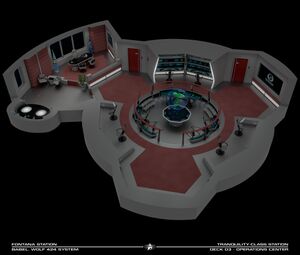
Sector Operations is a much smaller facility than Station Operations, located in one of the spires above the main body of the station. Primarily a communications center, this area allows Vice Admiral Elizabeth Hayden to stay abreast of starship movements within the Olympia Sector. The six stations in the center of the room are staffed by communications and intelligence specialists who can turn from their individual consoles to a view of the entire sector on a table between them. The consoles on the side of the room are each specific to exploratory, strategic, humanitarian, diplomatic, pathfinding, and colonial operations, liaising with the six elements of Fourth Fleet Operations. There are three entrances to the room, one side leading to the admiral's office and a small two-person transporter room, the set by the viewscreen leading to a conference room and ring of smaller offices for staff that encircles the operations center, and the other two leading to turbolifts which run the height of the spire down into the command module. The spire is fifteen decks tall with copies of this same deck layout on the even decks, providing spaces for each of the operations directors and the sector commander to have dedicated workspace. The odd decks contain communications and transporter equipment, as well as additional office space, except for the fifteenth deck, which has an observation dome providing uninterrupted views of space.
In an emergency, sector operations could take control of the station's systems, but standard security protocols are to evacuate the spire during combat situations, as it is in an exposed position. In such a scenario, a secondary sector operations facility in the heart of the station can be used.
Docking Facilities
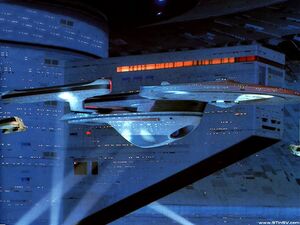
The upper spacedock has a four-armed docking column that supports up to sixteen midsized starships—midsized by 25th century terms, anyway. Each side of the arm can service two starships stacked vertically, with Berth A on top and Berth B on the bottom. The space doors at 90-degree angles along the rim of the upper dome leading into the bay are labeled 12, 34, 56, and 78, as they allow access to mooring points 1 & 2, 3 & 4, and so on, like a clock face. Halfway between each set of space doors is a band of six shuttle bays that also provide access to the interior of the bay, each with a docking control complex taking up the center; each docking control complex is responsible for the quadrant of space it faces. The upper docking module can only accommodate ships up to 245 meters wide, as the doors are 250 meters wide.
As with Gateway Station and the Starfleet Museum, Olympia Station's arboretum module was retrofitted to serve as a single large berth capable of servicing a single Odyssey-class heavy explorer. This bay, labeled bay 9, is in the middle third of the lower module and is 1,200 meters deep, 600 meters wide, and 200 meters tall. Bay 9 is equipped to perform baryon sweeps, albeit more slowly than dedicated facilities such as the Remmler Array. Below this bay are twelve large hangers.
The habitation modules above and below the lower docking module each have four shuttlebays. Runabouts, shuttles, and small civilian vessels have access to these dozens of hangers at various levels across the station, while larger vessels generally orbit the station when they don't need service.
Medical Facilities
Like all Spacedock-class stations, Olympia is equipped with a full-scale hospital to attend to patients from around the sector for whom starship-based medical facilities are not enough. In addition to the hospital, which has 3,000 ICU and acute care beds and 3,000 rehabilitative care beds, there are a number of smaller infirmaries located throughout the station.
Primary Infirmary
The primary infirmary is located in the station's command module. Its main purpose is to serve the medical needs of the station's operational crew. Patients are seen in two private examination rooms or in one of the three physicians' offices, and there are three medical labs en suite to help with fast and accurate diagnoses. More intensive diagnostics or surgeries in the attached surgical suite with two advanced biobeds and full isolation capabilities, while patients can be monitored during their recovery in an attached ward with fourteen beds. A further three private rooms are found in an attached isolation ward. This facility also includes a dedicated morgue. A transporter room is located directly adjacent to the infirmary to facilitate the quick movement of patients between this facility and the main hospital. The station's chief medical officer typically works from this infirmary, especially when the hospital is not experiencing significant volume. Copies of this facility are located on the promenade and in the habitation module.
Hospital
The station's hospital is located in the support module, which connects the habitat module to the transceiver module. Spread over thirty decks, this facility has a 500-bed ICU, 2,500 acute care beds, and facilities for up to 3,000 patients in physical or mental rehabilitative or chronic care. There are private rooms for all 6,000 patients, which can be increased to double beds should the need arise. These rooms are located on the outer structure of the decks, with diagnostic, treatment, and logistics facilities inboard. There is also a dedicated hanger set up to receive runabouts and ambulance vessels when transporters are not considered viable. The hospital has the ability to perform any type of treatment, with equipment ranging from stasis chambers to null-g facilities to microsurgery facilities. There are also dedicated high-resolution replicators for creating medical supplies. Most of the hospital remains in stand-by unless it is needed, though the staff practice regularly with holographic patients to keep their skills sharp.
Recreation Facilities
Arboretum & Promenade
In its original configuration, the lower docking module was dominated by a large arboretum that took up the upper two-thirds of the module, with the station's travel core running down the middle. Because of the addition of a large bay for an explorer-type vessel in this area, the arboretum has been shrunk substantially. Rather than a single large dome, there are four half-domes arranged together around the central travel column, with a botanical garden, a sports field, an amphitheater, and open park land each occupying one of the domes. Holographic projections show a view of the space beyond the dome, making it look as if they are on the outer hull.
The travel column continues down the center of the arboretum, but takes a horizontal path over the docking bay, before proceeding down again, and then back toward the center of the station under the docking bay. Ringing the arboretum are dozens of bars, restaurants, lounges, and shops in the station's promenade, which has connections to the central travel core through large passages at the intersections of each of the domes.
Elixir Lounge
The Elixir Lounge is a cocktail bar located on the edge of the promenade. Favored by senior officers and visiting dignitaries, this is an upscale establishment that serves drinks of all varieties, as well as appetizers and other small plates. Patrons enter this very wide establishment from the center, and there are two identical bars, one on each end of the room, with tables and casual seating options in the middle. Large, angular windows look out into space, and the ceiling has subtle art deco-style detailing.
History
The Olympia system has been home to an automated Starfleet deuterium refinery since the late 2370s, but plans for an eventual starbase to coordinate long-range exploration of the Alpha Quadrant were canceled during the Romulan Evacuation Mission. These plans never resumed due to Starfleet's inward-looking focus throughout the 2380s and 2390s. In 2400, the Fourth Fleet revived these plans. With the Spacedock-class Starbase Bravo recently replaced by a new Guardian-class station, Fourth Fleet Command decided to relocate the original Starbase Bravo to the Olympia System. During a year-long process, the station was refit and towed across Federation space to its new location. It was formally recommissioned in mid-2401, with Arcturus Squadron becoming the first exploratory group to call it home.
Notable Crew
Commanding Officers
In-Play
- Olympia Station is a station command assigned to Admiral Liam Dahlgren, but other members may visit in their stories, if no details of the setting are altered.
- Similar to Deep Space 17, Olympia Station is a waystation on one of the Federation's most distant frontiers. It is intended to fuel, supply, and repair ships for long missions outside of Federation space. It is approximately 300 light-years from Starbase Bravo, a two-week journey at Warp 9.99, and 128 light-years from Avalon Fleet Yards, a six-day journey at Warp 9.99. Slower ships would take weeks or months to reach the station.
- There are few direct threats to Olympia Station, as the Tamarians are friendly to the Federation and the Sheliak are uninterested in dealing with them. The Tholians can be a bit of a wildcard, though.
- Compared to other Starfleet starbases, Olympia Station has a lower civilian population, as it's not on a major trade route—at least not yet, as that will change when new colonies start to emerge.
